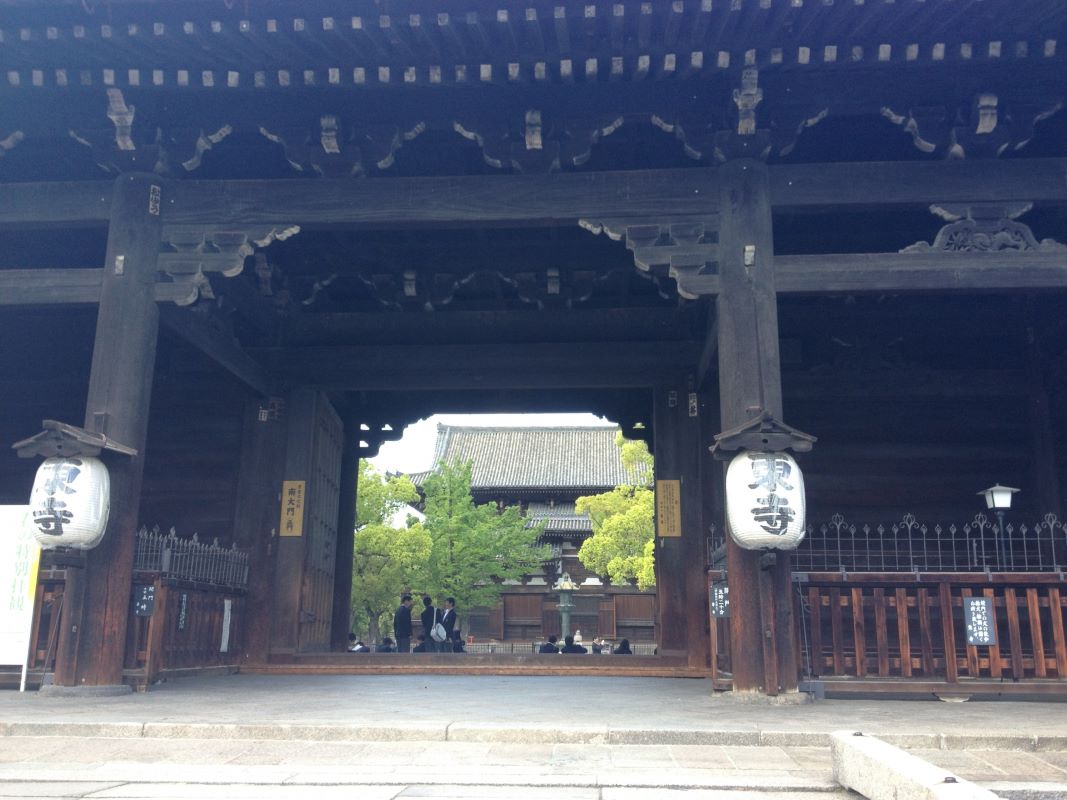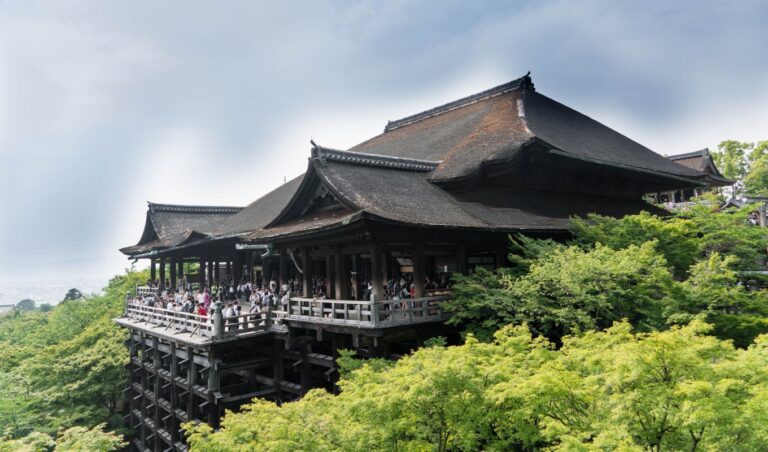Toji Temple is a World Heritage Site in the Minami-ku ward of Kyoto, Japan. It is a significant cultural and religious landmark that has been standing for over a thousand years. The temple was founded in 796 and was one of the only three Buddhist temples allowed in the city at the time it became the capital of Japan.

Today, Toji Temple is one of Kyoto’s most popular attractions, drawing visitors from all over the world.
The temple is renowned for its five-story pagoda, which stands at 57 meters tall and is the tallest wooden tower in Japan. The pagoda is a symbol of Kyoto and has become an iconic image of the city.

In addition to its impressive architecture, Toji Temple is also home to a vast collection of treasures designated as National Treasures or Important Cultural Properties. The temple’s Homotsukan (Treasure Hall) was built in 1963 as a treasure exhibition hall of Esoteric Arts and houses more than 20,000 treasures. You can explore the hall and view the temple’s extensive collection of artwork, sculptures, and other cultural artifacts.
History
 Founded in 796, it is one of the oldest and most important temples in Kyoto. The temple was originally built as a symbol of the emperor’s power, and it played an important role in the development of Japanese Buddhism.
Founded in 796, it is one of the oldest and most important temples in Kyoto. The temple was originally built as a symbol of the emperor’s power, and it played an important role in the development of Japanese Buddhism.
Origins
The temple was founded by Kukai, a famous Japanese monk who is also known as Kobo Daishi. Kukai was a student of the Chinese monk Huiguo, and he brought the teachings of Esoteric Buddhism to Japan. Kukai was an important figure in Japanese history, and he is still revered as a saint by many Japanese people.
When Kukai founded Toji Temple, he built it as a center for Esoteric Buddhism. Esoteric Buddhism is a form of Buddhism that emphasizes the use of rituals and meditation to achieve enlightenment. Toji Temple became one of the most important centers of Esoteric Buddhism in Japan, and it played an important role in the spread of the religion throughout the country.
Important events

Throughout its history, Toji Temple has been the site of many important events. During the Heian period, the temple was a center of political power, and it was often visited by members of the imperial family. In the 12th century, the temple was burned down during a civil war, but it was later rebuilt.
During the Edo period, Toji Temple was an important center of learning. The temple was home to a number of scholars and artists, and it played an important role in the development of Japanese culture. Today, the temple is a UNESCO World Heritage Site, and it is one of the most popular tourist attractions in Kyoto.
Throughout its long history, Toji Temple has been an important center of Japanese culture and religion. The temple has survived wars, fires, and earthquakes, and it remains a symbol of Japan’s rich cultural heritage.
Architecture
Toji Temple boasts a unique architectural style that sets it apart from other temples in Japan. The temple grounds feature buildings, including the Main Hall, Five-story Pagoda, and Bell Tower, each with its own distinct style and purpose.
Main Hall

The Main Hall, also known as Kondo, is the centerpiece of Toji Temple. It was constructed in the early Heian period and is the largest wooden building in Kyoto. The hall houses a statue of Yakushi Nyorai, the Buddha of healing, and is also used for ceremonies and events. The Main Hall is a designated National Treasure of Japan and is a must-see for visitors to the temple.
Five-story Pagoda

The Five-story Pagoda, or Goju-no-to, is the most recognizable feature of Toji Temple. Standing at 55 meters tall, it is the tallest wooden pagoda in Japan. The pagoda was originally built in the 9th century but has been rebuilt times due to natural disasters and fires. The current structure dates back to the Edo period and is a designated National Treasure of Japan. You can climb to the top of the pagoda for a stunning view of Kyoto.
Bell Tower
The Bell Tower, or Shoro, is next to the Five-story Pagoda and houses a large bell that is rung to mark the hours of the day. The tower was constructed in the 17th century and is a designated Important Cultural Property of Japan. You can also see a collection of Buddhist statues and artifacts in the tower.
Overall, Toji Temple’s unique architecture and interesting history make it a destination for anyone traveling to Kyoto. The temple’s buildings and artifacts have been meticulously preserved, and you can experience the beauty and grandeur of ancient Japanese architecture firsthand.
Gardens

Toji Temple is not only home to stunning architecture but also features beautiful gardens. You can take a leisurely stroll through the gardens and appreciate the natural beauty of the temple grounds.
Rock Garden
The rock garden at Toji Temple is a must-see for visitors. This type of garden, known as a karesansui, is a traditional Japanese garden that features carefully placed rocks and gravel. The rock garden at Toji Temple is particularly stunning, with a large rock formation that is said to represent a dragon.
The garden is designed to be viewed from the porch of the Kodo hall, which offers a great view of the rock garden. You can sit on the porch and take in the peaceful atmosphere while admiring the garden’s natural beauty.
Tea Garden

The tea garden at Toji Temple is a serene and peaceful spot that is perfect for relaxation. The garden features a small pond, a tea house, and a stone bridge. You can sit in the tea house and enjoy a cup of tea while admiring the view of the garden.
The tea garden is a great place to experience the traditional Japanese tea ceremony. The ceremony is a ritual that involves the preparation and serving of matcha, a powdered green tea. You can watch as the tea is prepared and served, and then enjoy a cup of tea yourself.
Cultural Significance

Toji Temple is one of the most significant Buddhist temples in Japan. It is known for its rich cultural heritage and religious significance. The temple has played an important role in the development of Buddhism in Japan and continues to be an important center of Buddhist worship and learning.
Buddhist Ceremonies
One of the most significant aspects of Toji Temple is its role in Buddhist ceremonies. The temple is home to a number of important Buddhist rituals, including the Goma Fire Ritual, which is held every day at the temple’s Kodo Hall. This ritual involves the burning of wooden sticks to purify the mind and spirit.
Another important ceremony held at Toji Temple is the Shuni-e Ceremony, also known as the “Omizutori” or “Water Drawing” ceremony. This ceremony is held annually in March and involves the drawing of water from a well at the temple, which is believed to have healing powers.
Festivals and Events
Toji Temple is also known for its festivals and events, which draw visitors from all over Japan and around the world. One of the most popular events is the Toji Temple Flea Market, held on the 21st of each month. This market is one of the largest in Kyoto and features a wide variety of goods, including antiques, clothing, and food.
Another popular event is the Toji Temple Autumn Festival, held in November. This festival features a number of traditional Japanese performances, including taiko drumming, dance performances, and tea ceremonies.
Overall, Toji Temple is an important cultural landmark in Japan, known for its rich history and cultural significance. Its role in Buddhist ceremonies and festivals makes it a popular destination for visitors looking to experience traditional Japanese culture.
Visiting Toji Temple
Toji Temple should be on your to do-list for anyone traveling to Kyoto. The temple is known for its iconic five-story pagoda, which is the tallest wooden tower in Japan. You can explore the temple grounds, view the pagoda up close, and learn about the history and culture of Kyoto. Below is everything you need to know about visiting Toji Temple.
Getting There
Toji Temple is in the southwestern part of Kyoto and is easily accessible by foot or train. You can walk 15 minutes from Kyoto Station to Toji Temple, or take the Kintetsu Kyoto Line to Toji Station and walk 10 minutes to the temple.
Hours and Admission
Toji Temple is open daily from 8:00 am to 5:00 pm. Admission to the temple grounds is 500 yen for adults and 400 yen for high school students. Children under the age of 12 are free. You can purchase tickets at the entrance gate or online in advance.
What to See

Aside from the pagoda, Toji Temple has other notable structures and artifacts worth seeing. You can explore the Kondo Hall, which houses a statue of the Yakushi Nyorai Buddha, and the Kodo Hall, which is home to a collection of Buddhist scriptures. The temple also has a beautiful garden with a pond, cherry blossom trees, and a tea house.
Tips for Visitors
- Visitors should plan to spend at least an hour exploring the temple grounds.
- The temple can get crowded, especially during peak tourist season, so visitors should arrive early in the morning or later in the afternoon to avoid crowds.
- Photography is allowed on the temple grounds, but visitors should be respectful of other visitors and not use flash photography inside the temple buildings.
- You can purchase souvenirs and snacks at the temple gift shop.



